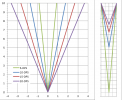I wouldn't be so sure...30° included is too wide to be considered as keen as it can be.
Anyway if honing at 16° included will bring you an edge 20°+ due to inavoidable convexing what angle do you believe end with starting honing at 30°? Not very keen i suppose.
High carbide steels pretty much have to be sharpened at 30° included and beyond, and that is the reason i prefer carbon steels that can handle lower edge angles with the necessary strenght.
Here is the link to some material that i believe could be interesting as relevant to this thread
https://scienceofsharp.wordpress.com/2015/02/09/the-pasted-strop-part-1/
I love ToddS' blog :thumbup: He presents in the post before this one a couple of angles for razor-blades, he also made me aware of one of Gillette's patents:
http://www.google.com/patents/WO2013010049A1?cl=en
"Keen" is related to
apex-diameter not edge-angle. The absolute
keenest blades are made from
pure tungsten carbide and achieve apex diameters in the 1nm range... with bevel angles >30 inclusive:
"Necessary strength" for what? What exactly do you think these low geometries "can handle"? ToddS can also provide you images of what happens to those carbon steel blades at such low geometry doing things as harsh as push-cutting a sheet of paper:
That fold-over results in a LESS KEEN edge than a blade sharpened to 40-inclusive gets cutting through a bunch of cardboard.
Here is a utility knife i used for a while, cutting carpet and plastic and rope and cardboard, bevel angle is ~16 inclusive:
And folk think an AXE (usually softer steel = weaker, more likely to squash or fold) can hold that geometry chopping wood???
Steve Elliot tested wood-planar blades for edge-retention at various angles (again, less heavy use than chopping) and found that going below 30-inclusive can result in excessive chipping even on CPM-3V while producing no real advantages in performance:
http://bladetest.infillplane.com/html/bevel_angles.html
Thickness provides strength via stiffness, material support behind the apex. The lower your bevel angle, the lower the thickness at a given distance behind the apex and the lower the strength in cubic proportion (i.e. 2X increase in thickness results in 8X increase in strength):

When you increase the bevel-angle from 20-inclsuive to 30, you increase the edge-thickness by ~50% and increase the strength by ~350%, and yet you do not affect "keen-ness" since whether the blade is 20-inclusive or 30, it can achieve the same level of apex-diameter refinement, indeed studies (Verhoeven) have shown that it may be easier to achieve a consistent lower apex diameter in the first place by sharpening at the higher bevel angle since that produces a stronger edge more resistant to fluctuations in the held-angle of the sharpener.
But the main point is, what "necessary strength" in what uses do you think your carbon blades achieve that the others cannot?



